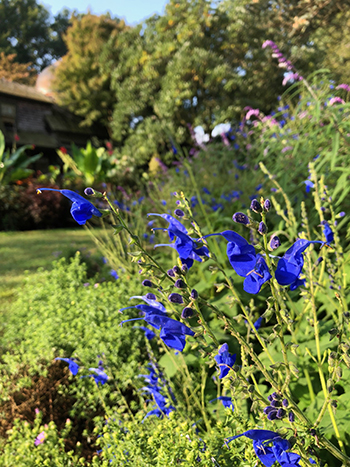
Plant of the Month: Salvia sagittata

The genus Salvia is a vast and diverse member of Lamiaceae, the flowering mint family. Many people are familiar with the common culinary sage, Salvia officinalis. Salvia hispanica is another well-known sage made famous in the late 1970s and 1980s with the jingle “Ch-ch-ch-chia.”
Chia Pets grow their trademark “hair” when moistened seeds of Salvia hispanica are rubbed over the terracotta figures. In recent years the consumption of chia has soared as a result of its “superfood” status. These two examples are merely the tips of the Salvia iceberg.
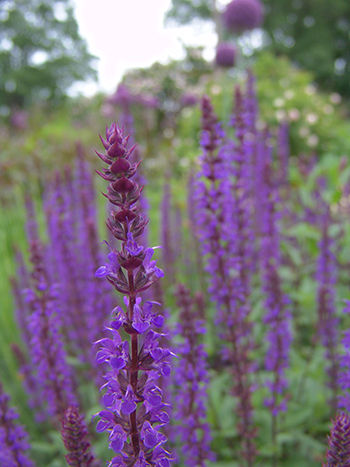
Salvia comes in a range of colors like the purple of Salvia nemorosa ‘Caradonna’. photo credit: R. Robert
Colorful, often fragrant, and in some instances edible, Salvia have adapted to many environments throughout the world. From evergreen to deciduous, herbaceous to tree-like, drought-tolerant to bog-loving there is likely a Salvia to fit just about any garden situation. Other attributes include resistance to deer browse and being excellent sources of nutrition for pollinators.
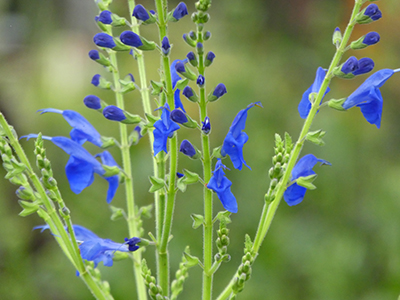
Salvia sagittata flowers, borne in abundance, are a brilliant blue, with a spreading lower lip. photo credit: M. Tipping
I especially love Salvia for the range of flower colors they add to the garden. Blue is an especially rare flower color. Few plants – Delphinium, Consolida, Gentiana, and Tweedia – boast blue blooms but none possess the sheer color range or duration of bloom as Salvia.
The search for a true blue all-summer-flowering plant led me to Salvia sagittata, the arrow leaf flowering sage. Salvia sagittata was collected and named in the late 1700s by Hipólito Ruiz López and José Antonio Pavón Jiménez, two Spanish botanists who spent ten years in the Andes on a commission by the government of Spain to search the New World for medicinal and agricultural plants.
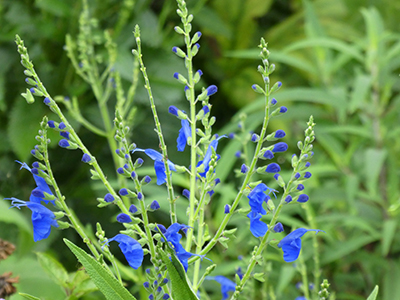
Salvia sagittata needs at least a half day of full sun for maximum bloom production. photo credit: M. Tipping
An evergreen, herbaceous flowering sage found throughout Ecuador, Chile, and Peru, it makes for an eye-catching annual in the mid-Atlantic. The specific epithet, sagittata, translates to “arrow-head-shaped,” a reference to the sagitate leaf shape. The inflorescences are very sticky, reaching up to 2’ above the leafy stems. The 1” flowers, borne in abundance, are a brilliant blue, with a spreading lower lip.
Salvia sagittata needs at least a half day of full sun for maximum bloom production. Unlike many other blue and purple Salvia, (Salvia leucantha for example), which require short days to initiate flower buds, S. sagittata begins blooming early and continues until frost.
Reaching 3 – 4’ in height and width, it makes an ideal mid-border plant where its lax habit can freely mix and mingle with its neighbors. Provide a well-drained soil that’s high in organic matter, regular watering, and a light feeding once or twice a month during rapid growth if planted in thin soils.
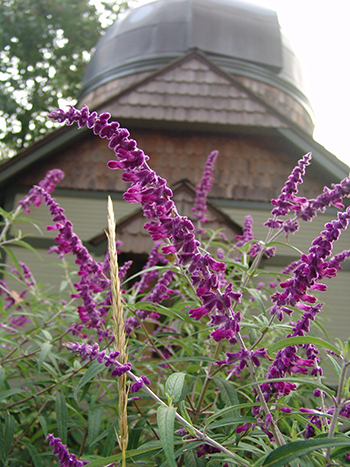
Pollinators like all salvia, including Salvia leucantha ‘Midnight’. photo credit: R. Robert
Pollinators, especially hummingbirds, adore Salvia. With that said, blue is not a typical color to which they are drawn. As such, mix red and orange-flowering plants amongst arrow leaf flowering sage. As the summer wanes to fall, snip cuttings with approximately four nodes and root in water. Salvia sagittata easily overwinters on a sunny windowsill throughout the winter months ensuring that you have this dynamic Salvia for seasons to come.
This true blue can be found at the 2019 Scott Arboretum Selections: Spring Sale on Saturday, May 11.





Wendy C
Posted at 06:29h, 02 MayI love salvias, my favourite is Salvia patens, so blue and blooms well. and easy to grow from saved seed. Also trying salvia azurea this year, easy from seed, too. Have never tried sagittata. Love that Midnight salvia.
rohit aggarwal
Posted at 04:12h, 28 Decemberthank you for giving me wonderful information
Becky Robert
Posted at 09:15h, 06 JanuaryYou are welcome, Rohit.
Happy Gardening,
Becky Robert
Scott Arboretum
Glynne Williams
Posted at 05:58h, 09 SeptemberNow September 2021 and have Sagitta, Blue Butterfly in a blue pot (!!) Grown for first time here for me. Thanks for information! So will overwinter in my heated greenhouse. Look for some cuttings. Great plant which I will plant amongst Neon, Jezebel and Hotlips next Summer. Thought it was a version of Patens, my favourite, but smaller, similar bloom. Thanks again for info.
Cynthia Rice
Posted at 09:49h, 25 DecemberDoes S. sagittata ave another name? I can’t find it in any of my books, including Hortus Third,, RHS Index of Garden Plants, Botanica, Seed germination, theory and Practice, Jelitto’s Hardy herbaceous perennials, Armitages Manual of Annuals, biennials, and Half…
I have seeds and am looking for germination requirements.
Mary Tipping
Posted at 09:40h, 11 JanuaryCynthia,
I’m pleased to know that you too enjoy Salvia sagittata. I am unsure if this is a revised name for the species, however, the name is accurate and current. The following germination information is from the B & T World Seeds website: “Salvia sagittata seeds will usually germinate in 10-14 days, even under good conditions germination may be erratic. Normally will only germinate with light so surface sow. Sow Salvia sagittata seeds on the surface of a Well drained seed sowing mix at about 20-25°C.” I hope that helps.
Best regards,
Mary Tipping
Curator, Scott Arboretum